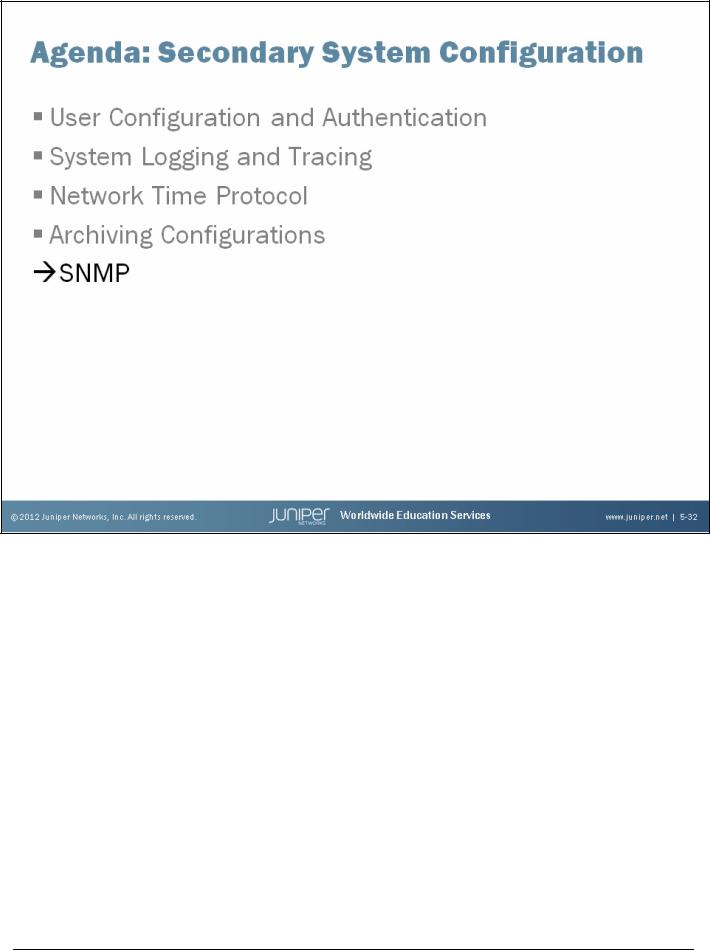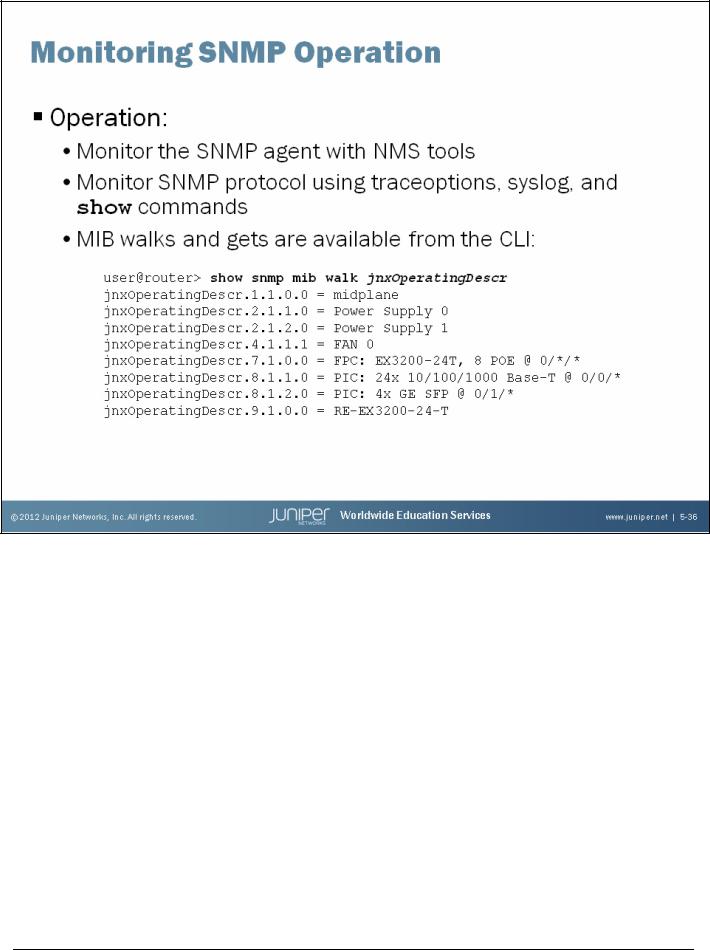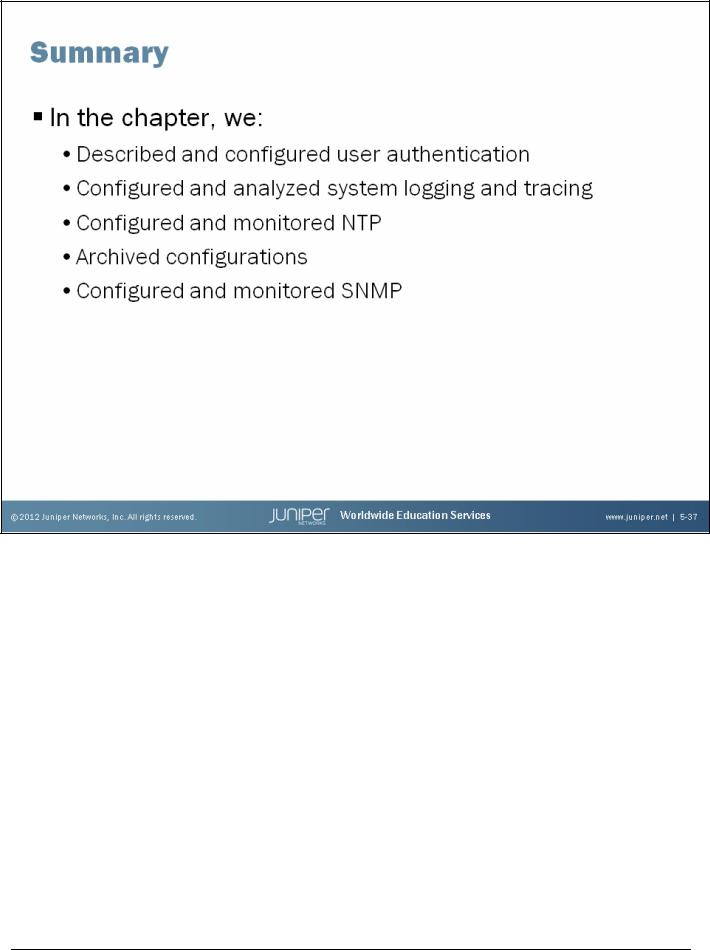
- •Contents
- •Course Overview
- •Course Agenda
- •Document Conventions
- •Additional Information
- •Chapter 1: Course Introduction
- •Chapter 2: Junos Operating System Fundamentals
- •The Junos OS
- •Traffic Processing
- •Overview of Junos Devices
- •Chapter 3: User Interface Options
- •User Interface Options
- •The Junos CLI: CLI Basics
- •The Junos CLI: Operational Mode
- •The Junos CLI: Configuration Mode
- •Lab 1: The Junos CLI
- •Chapter 4: Initial Configuration
- •Factory-Default Configuration
- •Initial Configuration
- •Interface Configuration
- •Lab 2: Initial System Configuration
- •Chapter 5: Secondary System Configuration
- •User Configuration and Authentication
- •System Logging and Tracing
- •Network Time Protocol
- •Archiving Configurations
- •SNMP
- •Lab 3: Secondary System Configuration
- •Monitoring Platform and Interface Operation
- •Network Utilities
- •Maintaining the Junos OS
- •Password Recovery
- •Lab 4: Operational Monitoring and Maintenance
- •Appendix A: Interface Configuration Examples
- •Review of the Interface Configuration Hierarchy
- •Interface Configuration Examples
- •Using Configuration Groups
- •Appendix B: The J-Web Interface
- •Configuration
- •Lab 5 (Optional): The J-Web Interface
- •Appendix C: Acronym List
- •Appendix D: Answer Key
- •Chapter 1: Course Introduction
- •Chapter 2: Junos Operating System Fundamentals
- •Chapter 3: User Interface Options
- •Chapter 4: Initial Configuration
- •Chapter 5: Secondary System Configuration
- •Chapter 6: Operational Monitoring and Maintenance

Introduction to the Junos Operating System
SNMP
The slide highlights the topic we discuss next.
Chapter 5–32 • Secondary System Configuration |
www.juniper.net |

Introduction to the Junos Operating System
SNMP Operation
Devices running the Junos OS act as SNMP agents. An SNMP agent exchanges network management information with SNMP manager software running on a network management system (NMS) or host. The agent responds to requests for information and actions from the manager. An agent communicates with the SNMP manager using the following message types.
•Get, Getbulk, or Getnext requests: The SNMP manager requests information from an SNMP agent. The agent responds with a Get response message.
•Set requests: The SNMP manager changes the value of a Management Information Base (MIB) object controlled by the agent. The agent returns the status in a Set response message.
•Notifications: The SNMP agent sends traps to notify the manager of significant events regarding the network device. SNMP version 3 uses informs to notify the manager of significant events. Informs increase SNMP reliability by requiring the receiver to acknowledge the receipt of an inform notification.
By polling managed network devices, the NMS collects information about network resources. An SNMP agent can also notify the NMS of events and resource constraints through the use of SNMP traps.
www.juniper.net |
Secondary System Configuration • Chapter 5–33 |

Introduction to the Junos Operating System
Management Information Bases
A MIB is a collection of objects maintained by the SNMP agent in a hierarchical fashion. The SNMP manager views or changes objects within the MIB structure. MIBs can be defined at the enterprise level to provide enterprise-specific information about the managed network device, or MIBs can be standardized to provide common information across multiple vendor network devices. NMS devices poll object identifiers (OIDs) to retrieve management information. An OID is considered a leaf in the tree-like hierarchy of a MIB. The Internet Engineering Task Force (IETF) provides standard MIBs you can download at http://www.ietf.org. You can download Juniper Networks enterprise MIBs at http://www.juniper.net/techpubs.
The Junos OS SNMP Support
The Junos OS provides support for SNMP versions 1, 2c, and 3. Version 1 is the initial implementation of SNMP that defines the architecture and framework for SNMP. Version 2 added support for community strings, which act as passwords determining access to SNMP agent MIBs. SNMPv3 is the most up-to-date version and provides enhanced security features including the definition of a user-based security model (USM) and a view-based access control model (VACM). SNMPv3 provides message integrity, authentication, and encryption, and is a superior security model over SNMPv2c, which uses plain text community strings. The Junos OS also provides support for remote monitoring (RMON) events, alarms, and history.
Chapter 5–34 • Secondary System Configuration |
www.juniper.net |

Introduction to the Junos Operating System
Sample SNMP Configuration
The slide shows a sample SNMP configuration using some common SNMP configuration options. When configuring contact information, you must be as specific as possible. This information is useful when trying to resolve issues with a network device. The example restricts SNMP access to the 10.210.14.0/24 network with read-only authorization. The example also shows the configuration of an SNMP trap group, necessary for the delivery of SNMP traps to an NMS.
www.juniper.net |
Secondary System Configuration • Chapter 5–35 |

Introduction to the Junos Operating System
The output generated from the command shown on the slide will vary depending on the device running the Junos OS on which the command is issued. As indicated in the output, the model used in this example was an EX3200.
Monitoring SNMP Operation
An NMS or host provides the interface for most SNMP monitoring. To monitor SNMP operation directly from a device running the Junos OS, you can use traceoptions, system logging, and various show snmp commands. When a trap condition occurs, some traps are logged if the system logging is configured with the appropriate facility and severity levels, regardless of whether a trap group is configured. The sample show command output on the slide illustrates that you can also issue standard SNMP manager commands to view agent OID values. You can specify the OIDs in ASCII text format or dotted-decimal notation.
Chapter 5–36 • Secondary System Configuration |
www.juniper.net |

Introduction to the Junos Operating System
This Chapter Discussed:
•User authentication methods and configuration;
•Configuration and analysis of system logging and tracing;
•NTP configuration and operation;
•Archiving of configurations on remote devices; and
•Configuration and monitoring of SNMP.
www.juniper.net |
Secondary System Configuration • Chapter 5–37 |

Introduction to the Junos Operating System
Review Questions
1.
Users can be authenticated using the local password database, RADIUS authentication, and TACACS+ authentication.
2.
The messages log is the primary syslog file, and is stored in /var/log directory. Use the show log messages command to view the messages log.
3.
Configuration archival allows for disaster recovery in situations where a system storage device becomes unusable. Archiving configurations can also be a useful part of a company’s configuration management policy.
4.
An SNMP trap is an agent-initiated notification of network events relative to the sending agent.
Chapter 5–38 • Secondary System Configuration |
www.juniper.net |
